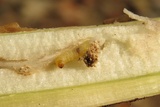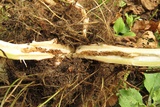Mompha jurassicella (Frey, 1881) Species
Last modified: Nov. 27, 2025, 12:15 p.m.
It is a not-so-common species throughout Belgium, but it is mainly observed in the northern part of the country. It is possibly overlooked, as larvae can be found in many locations where the host plant grows.
Details
- Classification
- Family: Momphidae > Genus: Mompha > Subgenus: Mompha > Species: Mompha jurassicella
- Vernacular names
- Wilgenroosjesboorder (NL), Weidenröschen-Fransenmotte (DE)
- First mention in Belgium
- De Prins W. & Steeman C. 2013. Interessante waarnemingen van Lepidoptera in België in 2012 (Lepidoptera). — Phegea 41(4): 82–85. On page 84 (as Mompha jurassicella (Frey, 1881)). view page
- Status
-
Native
Distribution
Bionomics
The larva makes a gallery of up to 25 cm in the pitch of the stem, preferably in larger, thicker stems. On the outside, there is no indication of their presence. When cutting an infected stem open in the lower half, one can notice the gallery that had been cut across. The gallery and frass are even more visible when splitting the stem in 2.
Before pupation the larva makes an exit hole leaving a thin piece of round or oval brown bark. The pupa does not protrude from the exit hole before emergence.
The species hibernate in the adult stage.
Flight periods
One generation a year from late August, and after hibernation until April.






















